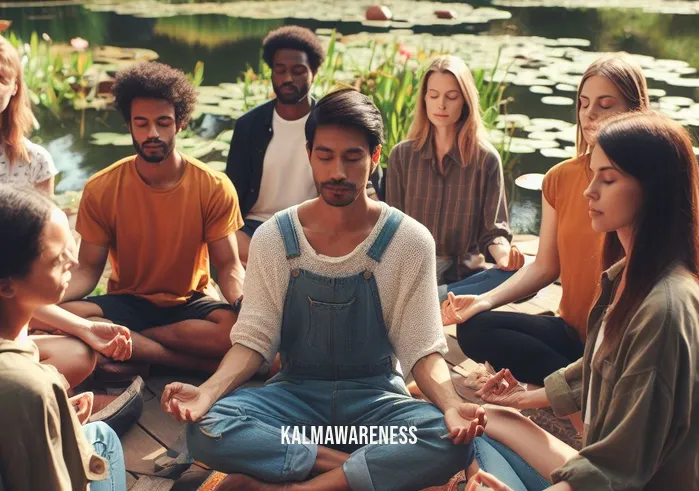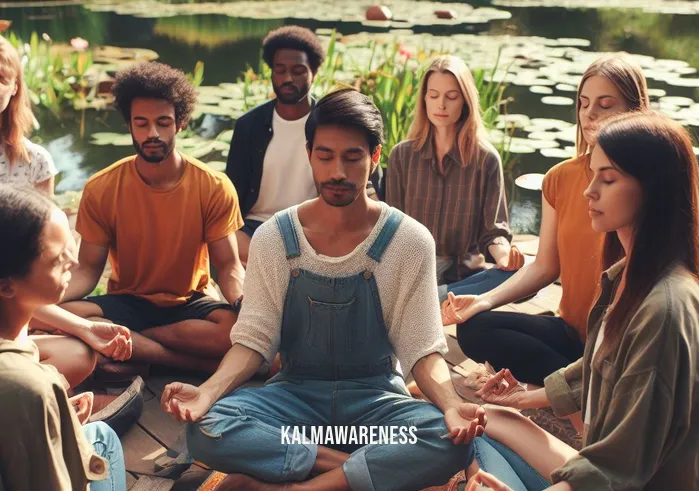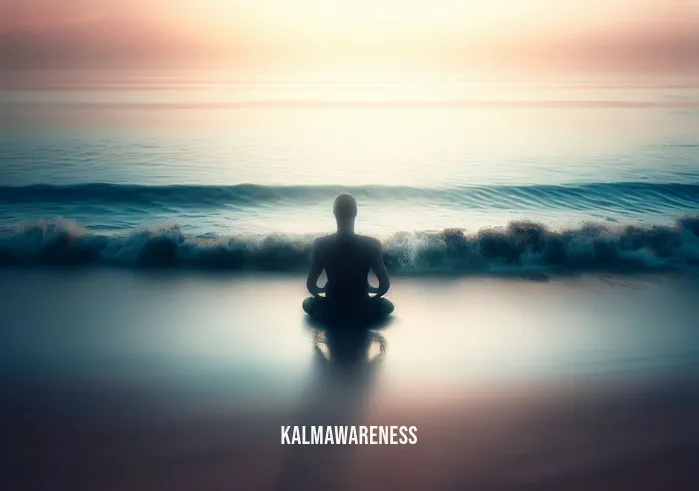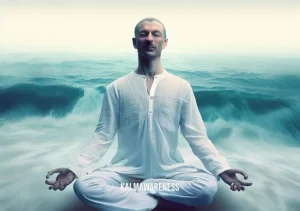Wind Down Meditation: The Secret to a Tranquil Evening
In today’s fast-paced world, taking a moment to ground oneself can seem like an elusive luxury. Amid the whirlwind of daily chores, work-related tasks, and personal commitments, the very idea of calm can seem distant. Enter the concept of wind down meditation. Rooted deeply in the principles of Meditation, this evening practice aims to help individuals transition from the bustling energy of day to the serene embrace of the night.
The Essence of Wind Down Meditation
Wind down meditation, at its core, is an exercise in Mindfulness. It’s not about forcefully emptying the mind but rather gently guiding it to a more peaceful state where thoughts are not consumed by incessant worries. As an ancient practice, meditation in many cultures has always underscored the importance of a peaceful state of mind where thoughts are not occupied by worry.
Why Evening?
There’s something inherently soothing about the evening—the gentle descent of the sun, the cool embrace of the night, and the promise of rest. The evening is the bridge between the day’s chaos and the night’s tranquility. Incorporating a wind-down meditation into your Evening routine ensures a smoother transition into a state of relaxation.
But why is relaxation so crucial in the evening? For starters, it prepares the body and mind for a restful sleep, a process that’s essential for both physical and mental well-being. There’s a reason why practices like Mindful hypnobirthing or EMDR meditation emphasize calm; a relaxed state allows for deeper healing, insight, and rejuvenation.
The Breathing Connection
Breathing plays a pivotal role in any form of meditation. In wind down meditation, the emphasis is on deep, rhythmic inhalations and exhalations. This deliberate act of Breathing and Meditation goes beyond mere physical function; it becomes a bridge to connect with one’s inner self.
Here’s an exercise to get started:
- Find a comfortable spot, either sitting or lying down.
- Close your eyes and take a deep breath in through the nose, counting to four.
- Hold the breath for a count of four.
- Exhale slowly through the mouth, counting to six.
- Repeat this cycle for a few minutes, focusing solely on your breath.
By the end of this simple exercise, you’ll find a noticeable difference in your state of mind. This is the power of conscious breathing—a tool that’s always with you, waiting to bring moments of mindful relaxation.
The Path Ahead
While the basic principles of wind down meditation might sound simple, there’s a world of depth to explore. From understanding the significance of 256 Hz benefits in sound meditation to learning advanced techniques on how to stabilize one’s mind, the journey ahead is rich and enlightening.
As you delve deeper into this practice, it’ll become more than just an evening routine. It’ll be a sanctuary—a space where the external world’s clamor fades, and all that remains is the profound silence of the present moment.
To truly harness the benefits of wind down meditation, one must approach it with an open heart and a curious mind. As the ancient sages remind us, it’s through understanding the self that we can truly connect with the world around us. Whether you’re a seasoned meditator or just starting, embracing this evening practice can be transformative.
Embark on this journey with us as we uncover more about the tools, techniques, and insights that make wind down meditation such an enriching experience. Ready to dive deeper? Continue reading in the next segment, where we’ll delve into the fascinating world of related meditation practices and their myriad benefits.

The Benefits and Methods of Wind Down Meditation
As we delve further into the realm of wind down meditation, it’s imperative to understand its multifaceted benefits and the diverse methods one can employ. This age-old practice, which emphasizes relaxation, mindfulness, and mental decluttering, plays an instrumental role in the rejuvenation of both body and mind.
Notable Benefits of Wind Down Meditation
Physical Restoration: Just like how sustainable self-care benefits our body, a good meditation session can improve sleep quality, reduce muscle tension, and stabilize blood pressure.
Mental Clarity: By allowing the mind to let go of judgment and embrace the present, it provides a unique space for introspection and clarity.
Emotional Equilibrium: Daily practice can help in regulating emotions, reducing instances of mood swings, irritability, and anxiety.
Enhanced Focus: Beyond mindfulness, it can sharpen one’s concentration, ensuring that tasks are undertaken with precision and attentiveness.
Spiritual Growth: For those on a spiritual journey, this form of meditation can foster a deeper connection to one’s inner self and the universe.
Integrating Wind Down Meditation into Your Evening Ritual
Setting the Ambiance: Ensure your meditation space is devoid of distractions. Dim the lights, play some soft ambient music, or even light a scented candle.
Choosing a Comfortable Position: While many practitioners prefer sitting, some find solace in lying down. Find what’s most comfortable for you.
Deep Breathing: As previously discussed, focused breathing is pivotal. Start with slow, rhythmic breaths to set the pace.
Visualization: Imagine a serene place — a beach, a forest, or even a Buddhist temple in Kansas City. Allow this visualization to become your temporary reality.
Affirmations: Silently repeat positive affirmations to yourself. Phrases like “I am at peace” or “I am not the body; I am not even the mind” can be potent.
Techniques and Their Core Focus: An Overview
| Technique | Core Focus | Duration |
|---|---|---|
| Guided Meditation | Visual journeys led by a narrator | 15-30 minutes |
| Body Scan | Bringing attention to various body parts sequentially | 10-20 minutes |
| Mindful Observation | Observing surroundings without judgment | 10-15 minutes |
| Loving-kindness Meditation | Cultivating compassion and love | 20-30 minutes |
| Mantra Meditation | Repetition of a sacred word or phrase | 15-30 minutes |
As with any practice, consistency is key. It’s less about the duration and more about the commitment. Some days might be challenging, and thoughts could be rampant. It’s important to remember that it’s entirely normal and part of the process. The goal is to observe without getting entangled.
As we conclude this chapter, it’s evident that wind down meditation offers an array of benefits. But how can we ensure maximum efficiency and understand the potential pitfalls? That’s precisely what we’ll delve into in the next segment. Prepare to uncover the nuances of this practice, ensuring that your wind down meditation journey is both enlightening and enriching. Continue reading to explore further.

Hope and Serenity: Drawing Inspiration from Wind Down Meditation
In our quest to understand the profound benefits and methods of wind down meditation, it becomes clear that the heart of this practice lies in the seeds of hope and inspiration it sows within us. As we navigate life’s inevitable ups and downs, the calming influence of this meditation reminds us to find peace within chaos and see the light in moments of darkness.
The Timeless Power of Words
One of the most effective ways to internalize the essence of wind down meditation is through the wisdom of thought leaders and luminaries who have walked the path of mindfulness and inner peace. Their words resonate with timeless truths, guiding us closer to our own epiphanies.
“Peace comes from within. Do not seek it without.” – Buddha
- A potent reminder that our external circumstances, however tumultuous, cannot disturb the peace that resides deep within us if we cultivate it with practices like mindful movement before sleep.
“In the midst of movement and chaos, keep stillness inside of you.” – Deepak Chopra
- Echoing the sentiments of the Buddha, Chopra stresses the importance of maintaining an internal sanctuary, untouched by external events—a sanctuary that wind down meditation helps create.
“The mind can go in a thousand directions, but on this beautiful path, I walk in peace.” – Thich Nhat Hanh
- This quote underscores the principle of being in the present and finding contentment in the current moment—a cornerstone of wind down meditation.
“Meditation is the tongue of the soul and the language of our spirit.” – Jeremy Taylor
- A testament to the profound spiritual journey one embarks upon when embracing practices like wind down meditation, which involve attaining a peaceful state of mind, unoccupied by worry.
“Do not dwell in the past, do not dream of the future, concentrate the mind on the present moment.” – Buddha
- Aligning perfectly with the essence of EMDR meditation, this quote emphasizes the therapeutic power of grounding oneself in the now, letting go of past traumas and future anxieties.
The Rippling Effect of Wind Down Meditation
When embraced consistently, the inspirational essence of wind down meditation extends far beyond the individual practitioner. It touches the lives of those around them, igniting a spark of hope, calm, and serenity. Like a gentle ripple in a pond, the peaceful energies cultivated within expand outwards, influencing our relationships, work, and overall worldview.
Whether it’s adopting a more empathetic perspective or handling stress with grace, the lessons learned through wind down meditation’s calming embrace stay with us, infusing our daily life with a touch of tranquility. Moreover, by regularly immersing ourselves in this practice, we subconsciously inspire others to embark on their own journey towards inner peace.
Embarking on Tomorrow’s Journey
As the sun sets on today’s introspection, our horizon is illuminated with the promises of a new dawn. Having understood the inspiration behind wind down meditation, we’re poised to delve deeper, exploring its potential pitfalls and challenges. No practice, however transformative, is without its set of obstacles. Recognizing and navigating these hurdles ensures that our meditation journey remains unhindered, potent, and deeply enriching.
In the next segment, we will pull back the curtains on the challenges one might face and arm ourselves with knowledge and strategies to overcome them. Dive deeper, for the journey is as rewarding as the destination. Continue reading and let the winds of wisdom guide your sail.

The Anatomy of Wind Down Meditation: A Deep Dive
As we journey deeper into the world of wind down meditation, it’s essential to meticulously unpack its various components. Understanding the nuances of this practice can transform a mere ritual into a profound experience, echoing benefits that ripple through various facets of life.
Core Elements of Wind Down Meditation
To truly grasp the essence of wind down meditation, it’s crucial to first break down its fundamental elements. Each component serves a unique purpose, collectively creating the meditative symphony that calms our mind and nourishes our soul.
Breath Awareness: Central to most meditation techniques, focusing on our breath, especially its natural rhythm, is foundational. It serves as a bridge, guiding our mind away from the chaotic external world and towards internal tranquility. The element of some meditation exercises like deep belly breathing can enhance this experience.
Body Scan: Grounding ourselves by mentally scanning our body, from the tips of our toes to the crown of our head, can be profoundly calming. This technique, often practiced in mindful hypnobirthing, establishes a deep connection between mind and body.
Guided Imagery: Harnessing the power of imagination, guided imagery encourages practitioners to visualize serene scenes—perhaps a tranquil forest or a serene beach. This visualization process often leads to a deeper state of relaxation.
Mantra Repetition: Mantras, which can be simple words or phrases, when repeated, can bring about a deep sense of calm and focus. They serve as anchors, keeping our minds from wandering into the territory of daily stressors.
Silent Observation: Here, the meditator merely observes their thoughts without judgment, an essential concept highlighted in judgment of the wise. This non-reactive observation creates a space between the practitioner and their thoughts, leading to a state of detached awareness.
Techniques to Amplify Your Wind Down Meditation Experience
Diversifying and deepening your meditation journey can be achieved by integrating various techniques. Here are some that complement wind down meditation:
Meditative Music: Incorporate soothing sounds, especially ones tuned to 256 Hz benefits, which is believed to promote healing and stimulate the body’s energy centers.
Yogic Practices: Combining wind down meditation with gentle yoga sequences, as explored in rouse yoga, can enhance the relaxation process.
Mindful Movement: Engaging in deliberate and slow movements, as opposed to rapid, thoughtless actions, ensures the body and mind are in harmony. This alignment is vital for a comprehensive wind down.
Lying Down Meditation: While meditation is often practiced seated, lying down to meditate can offer a different, equally calming experience.
Setting the Ambiance: Ensure the environment is conducive to relaxation. This could mean dimming the lights, lighting a fragrant candle, or ensuring the space is clutter-free.
Gearing Up for the Grand Finale
Having dived deep into the intricacies of wind down meditation, our voyage is far from over. The subsequent and concluding segment promises to be a synthesis of all we’ve gathered, accompanied by actionable steps and techniques to seamlessly integrate this practice into our daily routines. Stay tuned for an enlightening culmination, and let’s bring our exploration full circle in the next chapter.

A Gentle Farewell to Wind Down Meditation
As our exploratory voyage into the soothing world of wind down meditation draws to a close, we’re left with a sense of tranquility and newfound wisdom. These concluding thoughts are not an endpoint but rather a gentle pause, allowing us to reflect, appreciate, and look forward to future explorations.
The Heartbeat of our Journey
Over the course of our chapters, we’ve journeyed through the mindful movements conducive to sleep, witnessed the peace that comes with attaining a state of mind free from worry, and even touched upon the serene practices associated with Buddhist temples in Kansas City. The wind down meditation process, with its multifaceted techniques and core principles, has been our constant companion.
Reflecting on the entire process, we’re reminded of the phrase “I am not the body, I am not even the mind.” This tenet serves as a reminder of the impermanent nature of our thoughts and stresses, emphasizing the value of grounding ourselves in the present moment. By doing so, we pave the way for genuine relaxation and mental rejuvenation.
Celebrating the Wisdom Gained
Our excursion has not just been about understanding wind down meditation but also about embracing its essence in our daily lives. The subtle shifts in our mindset, the calm at the end of a chaotic day, and the promise of a restful night are all testaments to the transformative power of this practice.
With every deep breath, guided imagery, and silent observation, we’ve collectively experienced the undeniable magic of winding down. The dance between sustainable self-care and mindfulness, when harmoniously executed, brings forth a symphony of peace that resonates deep within.
Looking Ahead with Hope and Curiosity
As this chapter draws to a gentle close, our journey, in many ways, is just beginning. The world of mindfulness, relaxation, and meditation is vast, and there are countless avenues to explore, techniques to master, and moments of serenity to cherish.
Dive Deeper into Our Collection: If this expedition piqued your interest, delve into our extensive repository. Revisit past sections, uncover new practices, or simply immerse yourself in the world of mindfulness.
Heartfelt Gratitude
To our cherished readers, your engagement, curiosity, and willingness to embark on this journey have been the driving force behind our exploration. We’re humbled by your trust and eagerness to learn. As we bid adieu to our current topic, rest assured, more enriching content awaits in our future editions.
In the words of Jack Kornfield, whose insights on meditation for beginners are truly enlightening, “In meditation and in our daily lives, there are three qualities that we can nurture, cultivate, and bring out. We already possess these, but they can be ripened: precision, gentleness, and the ability to let go.”
Let these words guide you as you navigate the vast seas of mindfulness. Until our paths cross again, take care, stay curious, and cherish the tranquility that wind down meditation brings.





